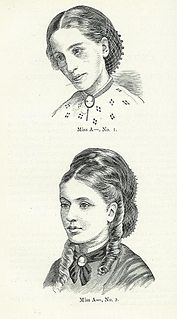Related Research Articles
An eating disorder is a mental disorder defined by abnormal eating behaviors that negatively affect a person's physical or mental health. Only one eating disorder can be diagnosed at a given time. Types of eating disorders include binge eating disorder, where the patient eats a large amount in a short period of time; anorexia nervosa, where the person has an intense fear of gaining weight and restricts food or overexercises to manage this fear; bulimia nervosa, where individuals eat a large quantity (binging) then try to rid themselves of the food (purging); pica, where the patient eats non-food items; rumination syndrome, where the patient regurgitates undigested or minimally digested food; avoidant/restrictive food intake disorder (ARFID), where people have a reduced or selective food intake due to some psychological reasons ; and a group of other specified feeding or eating disorders. Anxiety disorders, depression and substance abuse are common among people with eating disorders. These disorders do not include obesity. People often experience comorbidity between an eating disorder and OCD. It is estimated 20-60% of patients with an ED have a history of OCD.

Bulimia nervosa, also known as simply bulimia, is an eating disorder characterized by binge eating followed by purging or fasting, and excessive concern with body shape and weight. The aim of this activity is to expel the body of calories eaten from the binging phase of the process. Binge eating refers to eating a large amount of food in a short amount of time. Purging refers to the attempts to get rid of the food consumed. This may be done by vomiting or taking laxatives. Other efforts to lose weight may include the use of diuretics, stimulants, water fasting, or excessive exercise. Most people with bulimia are at a normal weight. The forcing of vomiting may result in thickened skin on the knuckles, breakdown of the teeth and effects on metabolic rate and caloric intake which cause thyroid dysfunction. Bulimia is frequently associated with other mental disorders such as depression, anxiety, borderline personality disorder, bipolar disorder and problems with drugs or alcohol. There is also a higher risk of suicide and self-harm. Clinical studies show a relationship between bulimia and vulnerable narcissism as caused by childhood 'parental invalidation' leading to a later need for social validation.
Appetite is the desire to eat food items, usually due to hunger. Appealing foods can stimulate appetite even when hunger is absent, although appetite can be greatly reduced by satiety. Appetite exists in all higher life-forms, and serves to regulate adequate energy intake to maintain metabolic needs. It is regulated by a close interplay between the digestive tract, adipose tissue and the brain. Appetite has a relationship with every individual's behavior. Appetitive behaviour also known as approach behaviour, and consummatory behaviour, are the only processes that involve energy intake, whereas all other behaviours affect the release of energy. When stressed, appetite levels may increase and result in an increase of food intake. Decreased desire to eat is termed anorexia, while polyphagia is increased eating. Dysregulation of appetite contributes to anorexia nervosa, bulimia nervosa, cachexia, overeating, and binge eating disorder.

Binge eating disorder (BED) is an eating disorder characterized by frequent and recurrent binge eating episodes with associated negative psychological and social problems, but without the compensatory behaviors common to bulimia nervosa, OSFED, or the binge-purge subtype of anorexia nervosa.
Unspecified feeding or eating disorder (UFED) is a DSM-5 category of eating disorders that, along with other specified feeding or eating disorder (OSFED), replaced eating disorder not otherwise specified (EDNOS) in the DSM-IV-TR.

The Eating Attitudes Test, created by David Garner, is a widely used 26-item, standardized self-reported questionnaire of symptoms and concerns characteristic of eating disorders. The EAT is useful in assessing "eating disorder risk" in high school, college and other special risk samples such as athletes. EAT has been extremely effective in screening for anorexia nervosa in many populations.

The National Eating Disorders Association (NEDA) is an American non-profit organization devoted to preventing eating disorders, providing treatment referrals, and increasing the education and understanding of eating disorders, weight, and body image. The National Eating Disorders Association organizes and sponsors National Eating Disorders Week. Also known as NEDAwareness Week, it takes place during the last week of February, and is "a collective effort of primarily volunteers, including eating disorder professionals, health care providers, students, educators, social workers, and individuals committed to raising awareness of the dangers surrounding eating disorders and the need for early intervention and treatment."
The Body Attitudes Test (BAT) was developed by Probst et al. in 1995. It was designed for the assessment of multiple eating disorders in women. The BAT measures an individual's subjective body experience and attitudes towards one's own body. It is a questionnaire composed of twenty items which yields four different factors that evaluate the internal view of the patient's own body.
The Eating Disorder Examination Interview (EDE) devised by Cooper & Fairburn (1987) is a semi-structured interview conducted by a clinician in the assessment of an eating disorder.
The SCOFF questionnaire utilizes an acronym in a simple five question test devised for use by non-professionals to assess the possible presence of an eating disorder. It was devised by Morgan et al. in 1999. The original SCOFF questionnaire was devised for use in the United Kingdom, thus the original acronym needs to be adjusted for users in the United States and Canada. The "S" in SCOFF stands for "Sick" which in British English means specifically to vomit. In American English and Canadian English it is synonymous with "ill". The "O" is used in the acronym to denote "one stone". A "stone" is an Imperial unit of weight which made up of 14 lbs. The letters in the full acronym are taken from key words in the questions:
The Binge Eating Scale is a sixteen item questionnaire used to assess the presence of binge eating behavior indicative of an eating disorder. It was devised by J. Gormally et al. in 1982 specifically for use with obese individuals. The questions are based upon both behavioral characteristics and the emotional, cognitive response, guilt or shame.
The Bulimia Test-Revised (BULIT-R) is a 36 item self-report questionnaire to assess the presence of bulimic symptoms. It was devised by Thelen et al. in 1991 the first version was devised by Thelen et al. in 1984. The test has been validated for use in both males and females.
The Anorectic Behavior Observation Scale (ABOS) is a thirty-item diagnostic questionnaire devised to be answered by the parents, spouse or other family member of an individual suspected of having an eating disorder. It was developed by Vandereyken et al. in 1992. The ABOS is useful for evaluations of patients with anorexia nervosa (AN) and bulimia nervosa (BN) before, during, and after clinical treatments. It can also be a significant tool for the screening of subjects in early-stage ED.
The Minnesota Eating Behavior Survey (MEBS) is a 30 item self-report questionnaire used to assess the presence of an eating disorder. It is designed for use with both male and females age 10 to adult. The MEBS was originally designed for use by McGue et al. in the Minnesota Twin Family Study (MTFS) a longitudinal study to assess the onset of psychological pathology including eating disorders among 1,400 twin girls and their parents.
The Eating Disorder Diagnostic Scale (EDDS) is a self-report questionnaire that assesses the presence of three eating disorders; anorexia nervosa, bulimia nervosa and binge eating disorder. It was adapted by Stice et al. in 2000 from the validated structured psychiatric interview: The Eating Disorder Examination (EDE) and the eating disorder module of the Structured Clinical Interview for DSM-IV (SCID)16.

Anorexia nervosa, often referred to simply as anorexia, is an eating disorder characterized by low weight, food restriction, body image disturbance, fear of gaining weight, and an overpowering desire to be thin. Anorexia is a term of Greek origin: an- and orexis, translating literally to "a loss of appetite"; the adjective nervosa indicating the functional and non-organic nature of the disorder. Anorexia nervosa was coined by Gull in 1873 but, despite literal translation, the feeling of hunger is frequently present and the pathological control of this instinct is a source of satisfaction for the patients.
Other specified feeding or eating disorder (OSFED) is a subclinical DSM-5 category that, along with unspecified feeding or eating disorder (UFED), replaces the category formerly called eating disorder not otherwise specified (EDNOS) in the DSM-IV-TR. It captures feeding disorders and eating disorders of clinical severity that do not meet diagnostic criteria for anorexia nervosa (AN), bulimia nervosa (BN), binge eating disorder (BED), avoidant/restrictive food intake disorder (ARFID), pica, or rumination disorder. OSFED includes five examples:
Grazing is a human eating pattern characterized as "the repetitive eating of small or modest amounts of food in an unplanned manner throughout a period of time, and not in response to hunger or satiety cues".
Paul E. Garfinkel is a Canadian psychiatrist, researcher and an academic leader. He is a Professor at the University of Toronto and a Staff Psychiatrist at Centre for Addiction and Mental Health (CAMH).
Body image disturbance (BID) is a common symptom in patients with eating disorders and is characterized by an altered perception of one's own body.
References
- ↑ Garner, David M.; Olmstead, Marion; Polivy, Janet (Spring 1983). "Development and validation of a multidimensional eating disorder inventory for anorexia nervosa and bulimia". International Journal of Eating Disorders. 2 (2): 15–34. doi:10.1002/1098-108x(198321)2:2<15::aid-eat2260020203>3.0.co;2-6. Archived from the original on 2012-10-18. Retrieved 7 December 2009.
- ↑ Psychosomatic Medicine 68:454.462
- ↑ Psychiatry Volume 18, Issue 3, May,2003
- ↑ International Journal of Eating DisordersVolume 4 Issue 4, Pages 511 - 523 Published Online: 13 Feb 2006 Sense of ineffectiveness in women with eating disorders
- ↑ Psychopathology Vol 37, No.4, 2004.
- ↑ Garner, D. M. (1991). EDI-2. Eating disorder inventory-2. Professional manual.